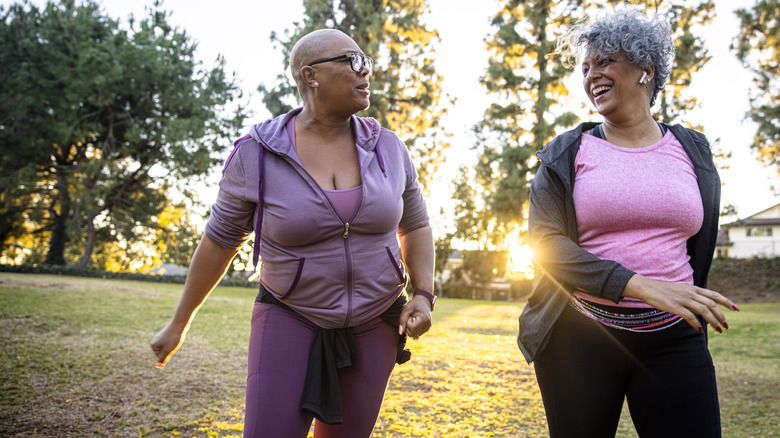Is It Safe To Exercise If You Have Low Blood Pressure? Everything To Consider
While exercise is an important piece of the puzzle when it comes to maintaining our mental and physical health, it can pose some risks for those with certain health conditions. For most healthy adults, the U.S. Centers for Disease Control and Prevention (CDC) recommends getting 150 minutes of moderate-intensity exercise on a weekly basis, along with two days composed of muscle-strengthening exercises. However, is it best for individuals with low blood pressure to modify some of these exercises, or perhaps avoid them altogether?
Medically referred to as hypotension, a person with a blood pressure reading that falls below 90/60 millimeters of mercury (mm Hg) is considered to have low blood pressure, according to experts at the Cleveland Clinic. While not everyone with low blood pressure may experience symptoms, others can be susceptible to fainting, dizziness, fatigue, nausea, vomiting, blurred vision, and more.
Low blood pressure may stem from the use of certain medications, various health conditions, injury, or many other conditions. "Whether it's safe to work out depends on why you have low blood pressure," fitness and nutrition expert Penny Weston told Stylist. "If you naturally have low blood pressure and have no symptoms, you'll generally be fine. However, before starting or changing an exercise regime, it's always worth checking with a health practitioner."
Safe exercises for people with hypotension
Exercise can be greatly beneficial for those with hypotension. However, patients will want to be mindful about the kinds of physical activities they engage in. According to experts at Sprint Medical, low-impact exercise is the safest option. Therefore, activities such as swimming, cycling, or walking are all excellent options. In fact, it's advised that patients strive to get in one half-hour or more of walking on a daily basis. Alternatively, pilates can also be particularly helpful for those with low blood pressure, as these exercises can boost circulation.
Exercises that target stress are also advisable for people with low blood pressure, such as tai chi or certain yoga positions. Even better, consider complementing these physical activities with deep breathing exercises. Not only will you be keeping stress levels low, but diaphragmatic breathing, in particular, can also support increased blood flow.
Yet just as some exercises are considered safe for patients with hypotension, there are also exercises that can be potentially unsafe. Here are some physical activities to steer clear of if you have low blood pressure.
Exercises that may be unsafe for patients with low blood pressure
"It's a good idea to avoid exercises that involve your head being level with, or below, your heart," Penny Weston went on to tell Stylist. Think crunches, for example. The reason is that engaging in these exercises can potentially exacerbate symptoms of dizziness or nausea for those with low blood pressure. Additionally, it's best to avoid any physical activity that may cause you to overexert yourself, such as high-intensity cardio exercise or hot yoga.
But it's not just the exercises themselves that we should keep in mind. It's also important to practice healthy pre- and post-workout habits if you have low blood pressure, such as eating a small snack prior to exercise. Additionally, don't forget to prime your body for physical activity with a little stretching beforehand. Just be sure to do so while standing upright. Afterward, give your body the time it needs to cool off — and we don't mean with a shower. Jumping right into a hot shower after exercise can actually cause one's blood pressure to decrease further. Instead, give yourself a cool-down walk and then wait at least an hour before getting squeaky clean.



